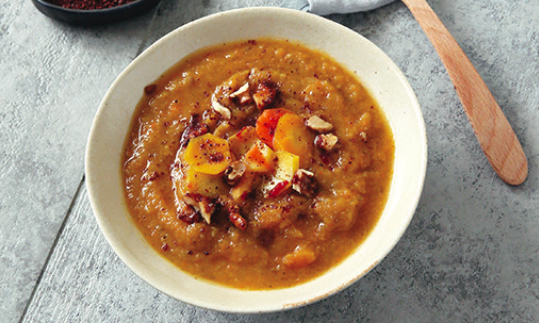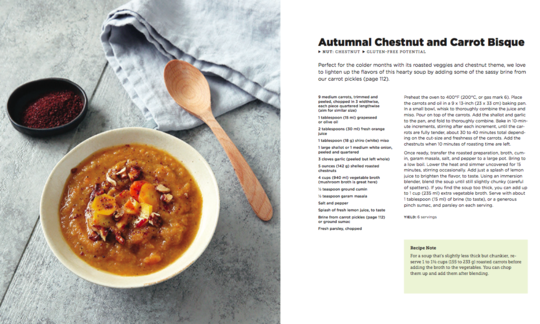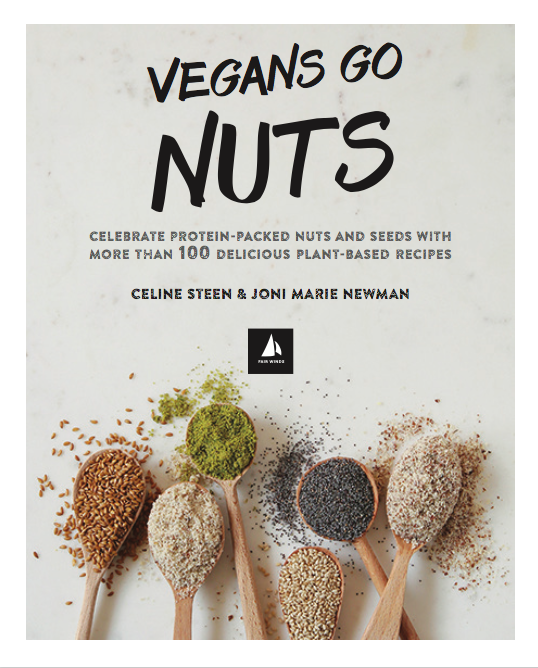Autumnal Chestnut and Carrot Bisque with Garam Masala
vegan
Ingredients (for servings, )
| For the chestnuts | |
|---|---|
| 4 ¾ oz | Sweet chestnuts, European, raw, unpeeled |
| For the bisque | |
| 9 | Carrots (carrots), raw (organic?) (19 oz) |
| 1 tbsp | Grape seed oil (grapeseed oil) (0.48 oz) |
| 2 tbsp | Orange juice (raw?, organic?) (0.52 oz) |
| 1 tbsp | Miso (soybean paste) (0.60 oz) |
| 1 | Shallots, raw (organic?) (0.70 oz) |
| 3 cloves | Garlic (organic?) (0.32 oz) |
| 940 ml | Vegetable broth without added salt (organic?) (33 oz) |
| ½ tsp | Cumin, ground (raw, organic?) (0.05 oz) |
| ½ tsp | Garam Masala (spice mix, raw?, organic?) (0.04 oz) |
| 1 dash | Table salt (table salt, raw?, organic?) (0.01 oz) |
| 1 dash | Black pepper (organic?, raw?) (0.00 oz) |
| 1 tsp | Lemon juice (raw?, organic?) (0.09 oz) |
| For serving | |
| ½ tsp | Gerber sumac, raw (sumac, organic?) (0.06 oz) |
| 2 tbsp | Parsley, fresh, raw (leaf parsley, parsley) (0.27 oz) |
Equipment
- hand-held blender / immersion blender
- stove
- citrus juicer (lemon squeezer)
- saucepan
- oven
- casserole dish (baking dish)
Type of preparation
- cook
- bake
- chop or grind
- blend
- squeeze
- dry roast
- bring to a boil
- remove the skin
- peel
- simmer
Preparation
For the chestnuts
Preheat the oven to 400 °F (200 °C or gas mark 6). Cut an “X” into the top of the chestnuts and place them directly on an oven rack. Roast for about 20–30 minutes. Let them cool down a bit and then peel. Put aside.You can easily prepare the chestnuts in advance, for example, the day before. Cutting an “X” into the top prevents the chestnuts from exploding. When the chestnuts are ready, they should have opened significantly and the skin will be darker. If you place a heat-resistant bowl with water in the oven, the chestnuts will not dry out as much.
For the bisque
Peel the carrots and cut into thirds. Cut each of these pieces lengthwise into four carrot sticks (aim for a similar size). Place the carrots and oil in a 9 x 13-inch (23 x 33 cm) baking pan.In a small bowl, whisk to thoroughly combine the freshly squeezed orange juice and miso. Pour on top of the carrots.
The authors use shiro (white) miso.
Peel the shallot and cut into quarters. Add the shallot and garlic (peeled but left whole) to the pan, and fold to thoroughly combine. Bake in 10-minute increments, stirring after each increment, until the carrots are fully tender, about 30 to 40 minutes total depending on the cut-size and freshness of the carrots.
The authors suggest using 1 large shallot or 1 medium-size white onion.
Add the chestnuts when 10 minutes of roasting time are left.
Once ready, transfer the roasted preparation, broth, cumin, garam masala, salt, and pepper to a large pot. Bring to a low boil. Lower the heat and simmer uncovered for 15 minutes, stirring occasionally.
Recipe note from authors: “For a soup that’s slightly less thick but chunkier, reserve 1 to 1½ cups (155 to 233 g) roasted carrots before adding the broth to the vegetables. You can chop them up and add them after blending.”
The authors suggest using mushroom broth for the vegetable broth. For health reasons, we have intentionally chosen a low-salt vegetable broth. More information can be found under “Alternative preparation.”
Add just a splash of fresh lemon juice to brighten the flavor, to taste.
Using an immersion blender, blend the soup until still slightly chunky (careful of spatters). If you find the soup too thick, you can add up to 1 cup (235 mL) extra vegetable broth.
For serving
Garnish each serving with a generous pinch sumac, and parsley.Instead of sumac, you can use about 1 tablespoon (15 mL) of brine (to taste).
|
Nutritional Information per person
Convert per 100g
|
2000 kcal | |
|---|---|---|
| Energy | 160 kcal | 8.0% |
| Fat/Lipids | 6.0 g | 8.6% |
| Saturated Fats | 2.1 g | 10.6% |
| Carbohydrates (inc.dietary fiber) | 25 g | 9.3% |
| Sugars | 6.3 g | 7.0% |
| Fiber | 6.3 g | 25.0% |
| Protein/Albumin | 3.0 g | 6.1% |
| Cooking Salt (Na:222.9 mg) | 566 mg | 23.6% |
| Essential micronutrients with the highest proportions | per person | 2000 kcal | |
|---|---|---|---|
| Vit | Vitamin A, as RAE | 926 µg | 116.0% |
| Vit | Vitamin K | 33 µg | 44.0% |
| Vit | Vitamin C (ascorbic acid) | 25 mg | 31.0% |
| Sodium, Na | 223 mg | 28.0% | |
| Prot | Threonine (Thr, T, irreversibly transaminated) | 0.26 g | 28.0% |
| Elem | Potassium, K | 536 mg | 27.0% |
| Min | Manganese, Mn | 0.53 mg | 27.0% |
| Vit | Vitamin B9, B11 (Folate, as the active form of folic acid) | 47 µg | 24.0% |
| Min | Copper, Cu | 0.23 mg | 23.0% |
| Vit | Vitamin B6 (pyridoxine) | 0.32 mg | 23.0% |
Detailed Nutritional Information per Person for this Recipe
The majority of the nutritional information comes from the USDA (US Department of Agriculture). This means that the information for natural products is often incomplete or only given within broader categories, whereas in most cases products made from these have more complete information displayed.
If we take flaxseed, for example, the important essential amino acid ALA (omega-3) is only included in an overarching category whereas for flaxseed oil ALA is listed specifically. In time, we will be able to change this, but it will require a lot of work. An “i” appears behind ingredients that have been adjusted and an explanation appears when you hover over this symbol.
For Erb Muesli, the original calculations resulted in 48 % of the daily requirement of ALA — but with the correction, we see that the muesli actually covers >100 % of the necessary recommendation for the omega-3 fatty acid ALA. Our goal is to eventually be able to compare the nutritional value of our recipes with those that are used in conventional western lifestyles.
| Essential fatty acids | per person | 2000 kcal |
|---|---|---|
| Linoleic acid; LA; 18:2 omega-6 | 2.1 g | 21.0% |
| Alpha-Linolenic acid; ALA; 18:3 omega-3 | 0.07 g | 4.0% |
| Essential amino acids | per person | 2000 kcal |
|---|---|---|
| Threonine (Thr, T, irreversibly transaminated) | 0.26 g | 28.0% |
| Tryptophan (Trp, W) | 0.04 g | 15.0% |
| Isoleucine (Ile, I) | 0.16 g | 13.0% |
| Lysine (Lys, K, irreversibly transaminated) | 0.22 g | 12.0% |
| Valin (Val, V) | 0.17 g | 11.0% |
| Leucine (Leu, L) | 0.22 g | 9.0% |
| Phenylalanine (Phe, F) | 0.14 g | 9.0% |
| Methionine (Met, M) | 0.05 g | 5.0% |
| Vitamins | per person | 2000 kcal |
|---|---|---|
| Vitamin A, as RAE | 926 µg | 116.0% |
| Vitamin K | 33 µg | 44.0% |
| Vitamin C (ascorbic acid) | 25 mg | 31.0% |
| Vitamin B9, B11 (Folate, as the active form of folic acid) | 47 µg | 24.0% |
| Vitamin B6 (pyridoxine) | 0.32 mg | 23.0% |
| Vitamin B1 (Thiamine) | 0.16 mg | 15.0% |
| Vitamin E, as a-TEs | 1.6 mg | 13.0% |
| Vitamin B7 (Biotin, ex vitamin H) | 6.5 µg | 13.0% |
| Vitamin B2 (Riboflavin) | 0.15 mg | 11.0% |
| Vitamin B3 (Niacin) | 1.7 mg | 11.0% |
| Vitamin B5 (Pantothenic acid) | 0.61 mg | 10.0% |
| Vitamin B12 (Cobalamin) | 0.00 µg | < 0.1% |
| Essential macroelements (macronutrients) | per person | 2000 kcal |
|---|---|---|
| Sodium, Na | 223 mg | 28.0% |
| Potassium, K | 536 mg | 27.0% |
| Phosphorus, P | 93 mg | 13.0% |
| Calcium, Ca | 67 mg | 8.0% |
| Magnesium, Mg | 29 mg | 8.0% |
| Essential trace elements (micronutrients) | per person | 2000 kcal |
|---|---|---|
| Manganese, Mn | 0.53 mg | 27.0% |
| Copper, Cu | 0.23 mg | 23.0% |
| Iron, Fe | 1.3 mg | 9.0% |
| Zinc, Zn | 0.63 mg | 6.0% |
| Iod, I (Jod, J) | 6.0 µg | 4.0% |
| Selenium, Se | 0.56 µg | 1.0% |
| Fluorine, F | 4.5 µg | < 0.1% |
'Vegans Go Nuts - celebrate protein packed nuts and seeds with more than 100 delicious plant-based recipes’ shows the diversity of nuts and seeds.
ConclusionIn Vegans Go Nuts, Celine Steen and Joni Marie Newman show the many ways in which nuts and seeds can be used. Unfortunately, the authors do not go into the major differences in the health values of the individual nuts. Also, despite the many nuts and seeds, additional oils are often used. However, by consciously using nuts with health benefits and making slight changes, you can prepare new and healthy vegan recipes with the help of the recipes listed.
|
Critical book reviews |
General impressionIn Vegans Go Nuts - celebrate protein packed nuts and seeds with more than 100 delicious plant-based recipes, Celine Steen and Joni Marie Newman have put together a large selection of nut and seed-based vegan recipes. The authors start by introducing a wide variety of nuts and seeds. They focus in particular on the differences in flavours and textures after processing the nuts and seeds and highlight the health benefits of the individual ingredients. However, this means that the disadvantages take a back seat. It would be desirable to compare the nuts in terms of their health value, in particular the ratio of omega-6 to omega-3 fatty acids, which should not exceed a ratio of 5:1. This would make it easier to select the appropriate nuts in the dishes - as the type of nut is often left to the reader's discretion. The authors emphasise that nuts and seeds are particularly beneficial in raw or dry roasted and unsalted form. The statement that all nuts are healthy, regardless of the type, is not entirely correct, especially in view of the very different ratios of essential fatty acids. You can find out more about this under the following link: Vegans often eat unhealthily.
The recipes are clearly presented and are labelled gluten-free, soy-free, oil-free and quick and easy. The additional tips (recipe notes) are a helpful addition. Unfortunately, only some of the recipes are illustrated. An additional indication of preparation times would be desirable with regard to planning. The use of many different nuts and seeds and the frequent use of wholegrains are successful from a health perspective. Unfortunately, despite the many nuts and seeds, added oils are still frequently used, but rarely a lot. Sweeteners of various kinds are also often present and, especially in desserts, in large quantities. It would be preferable to reduce these or switch to fruit sweeteners. Tinned food is also found in around one in ten dishes. A complete avoidance of processed products would also be preferable here. It is pleasing to see that many home-made ingredients such as nut butter, nut milk and similar are used, which are listed in the basics.
Vegans Go Nuts by Celine Steen and Joni Marie Newman is a vegan recipe book that demonstrates the versatility of nuts and seeds through its varied recipes.
By making slight changes and consciously using particularly healthy nuts, you can conjure up not only delicious but also healthy vegan dishes from many of the recipes listed. Vegans Go Nuts by Celine Steen and Joni Marie Newman is currently only available in English. You can buy it from Quarto Knows and Amazon.
About the authorsCeline Steen, who lives in California, switched to a vegan diet in 2005 for ethical reasons. She is the co-author of several cookery books and founder of the award-winning blog Have Cake, Will Travel.
Joni Marie Newman is the founder of justthefood.com and author of 10 cookery books. She is well known in the vegan community and is a frequent speaker at vegan conferences and other events.
Contents of the bookVegans Go Nuts is divided into 6 chapters:
- In the Kitchen with Nuts and Seeds
- Nuts and Seeds Basics
- Cheers to Nutritious Mornings
- Simple Nuts Make Mean Mains
- Substantial Soups, Sides, and Salads
- Ending Things on a Sweet Nut
In the kitchen with nuts and seeds: Here you will find a glossary of nuts and seeds, tips on storing them and a glossary of some more unusual ingredients.
Recipes
Nuts and Seeds Basics: The recipes range from simple roasted nuts to nut butters, nut milks, nut flours, spreads, dressings, dips and nut cheeses. Examples include the Almond-Milk Cream Cheese Spread and the Citrusy Cashew Baba Ghanoush.
Cheers to Nutritous Mornings:Here you will find sweet or savoury dishes in the form of muesli, pastries or savoury dishes, such as the Ginger or Lemon Tahini Scones, Banana Nut Bread Pancakes or the Protein-Packed Breakfast Scramble. You will need sweeteners for almost all the dishes, and tinned food is used for three of them.
Simple Nuts make Mean Mains: The dishes are based on quinoa, rice, chickpeas, noodles and tofu, among other things. Just under a third of the recipes require bread or tortillas, which are not part of the recipes. In 5 recipes, the authors use ready-made products (sauces and tinned food). Examples of the recipes listed are the Moroccan Pilaf with Pomegranate Walnuts, Pad Tahini and Walnut, Arugula and Grape Tacos.
Substantial Soups, Sides, and Salads: Dishes such as Potato Peanut Soup, Autumnal Chestnut and Carrot Bisque and Cauliflower Pecan Tabouleh can be served as a main course, side dish or starter.
Ending Things on a Sweet Nut: You will find toppings, ice cream, biscuits and small sweet treats here. Examples include the Baked Pears, Pistachio Macarons with Orange Ganache Filling and Nut Butter Magic Candy Ice Cream Topping. Almost all the recipes contain a fairly high proportion of sweeteners.
The cookbook Vegans Go Nuts - Nuts and Seeds with more than 100 delicious plant-based recipes concludes with a recipe index.
Book review by Dr med. vet. Inke Weissenborn
Autumnal Chestnut and Carrot Bisque with Garam Fasala is a flavorful soup that is perfect for the colder months.
Nutritional profile: According to GDA guidelines, one serving of this recipe covers the recommended daily requirement for vitamin A. In addition, it meets almost 50 % of the daily recommended requirement for vitamin K and about ¼ the recommended requirement for vitamin C.
Bisque: Bisque refers to a puréed soup originally from France. Today, the term is mainly used in gastronomy for soups made from lobster, langoustine, crab, shrimp, or crayfish.
Sweet chestnuts vs. horse chestnuts: Sweet chestnuts (Castanea sativa) are the edible chestnuts used to make roasted chestnuts. In Europe, they are sold at Christmas markets under names like “Maroni” and “Maronen.” In contrast, horse chestnuts (Aesculus hippocastanum) are toxic and inedible. They are the variety most commonly found in forests and backyards
Compared to other nuts, chestnuts contain considerably less fat and fewer calories. Given the high starch and fiber content, chestnuts are very filling. They have a sweet, nutty flavor and are delicious. Furthermore, chestnut flour is gluten-free and can be used as a flour substitute for people who have a gluten intolerance (celiac disease).
Sumak: Sumak is a typical Arabic or oriental spice and is actually called Sicilian sumac, tanner’s sumach, or elm-leaved sumach. The acidic dark red spice is often mixed with salt and is particularly popular in Turkish, Arabic, Kurdish, and Persian cuisine.
Cumin: As they have a similar name in many languages (e.g., in German: “Kreuzkümmel” and “Kümmel”), cumin and caraway are often confused. However, they actually aren’t closely related and have a very different flavor. Cumin is often used in Indian, Turkish, and Greek cuisine.
Garam masala: This Indian spice mix contains many spices, such as black cardamom, cinnamon, cloves, black pepper, and cumin. Chili and coriander seed is also often included. You can buy garam masala as a spice mix, usually ground, in Indian grocery stores, well-stocked supermarkets, or online. When made from whole spices, garam masala stays aromatic and fresh longer.
Miso and raw food: Miso is a Japanese paste that is made from soybeans and either rice, barley, or another type of grain. It is a natural flavor enhancer that tastes like fermented beans and can be sweet or spicy. Strictly speaking, miso is not a raw product since the soybeans are heated during the production process in order to deactivate the glycoprotein phasin, which is toxic for humans.
Mushroom vegetable broth: The authors recommend using a mushroom vegetable broth for this recipe. To make your own, go here: Organic Mushroom Vegetable Broth.
Reducing the salt: If you would also like to reduce the salt content of other recipes that call for large amounts of vegetable breath, we recommend using a very low-salt vegetable broth or stock. For more helpful information about diet and health, please see our article: A Vegan Diet Can Be Unhealthy. Nutrition Mistakes.
Follow the link for a recipe to make your own extra low-salt vegetable broth: Low-Salt Vegetable Broth.
You can find a recipe to make your own vegan stock here: Vegan Stock.






